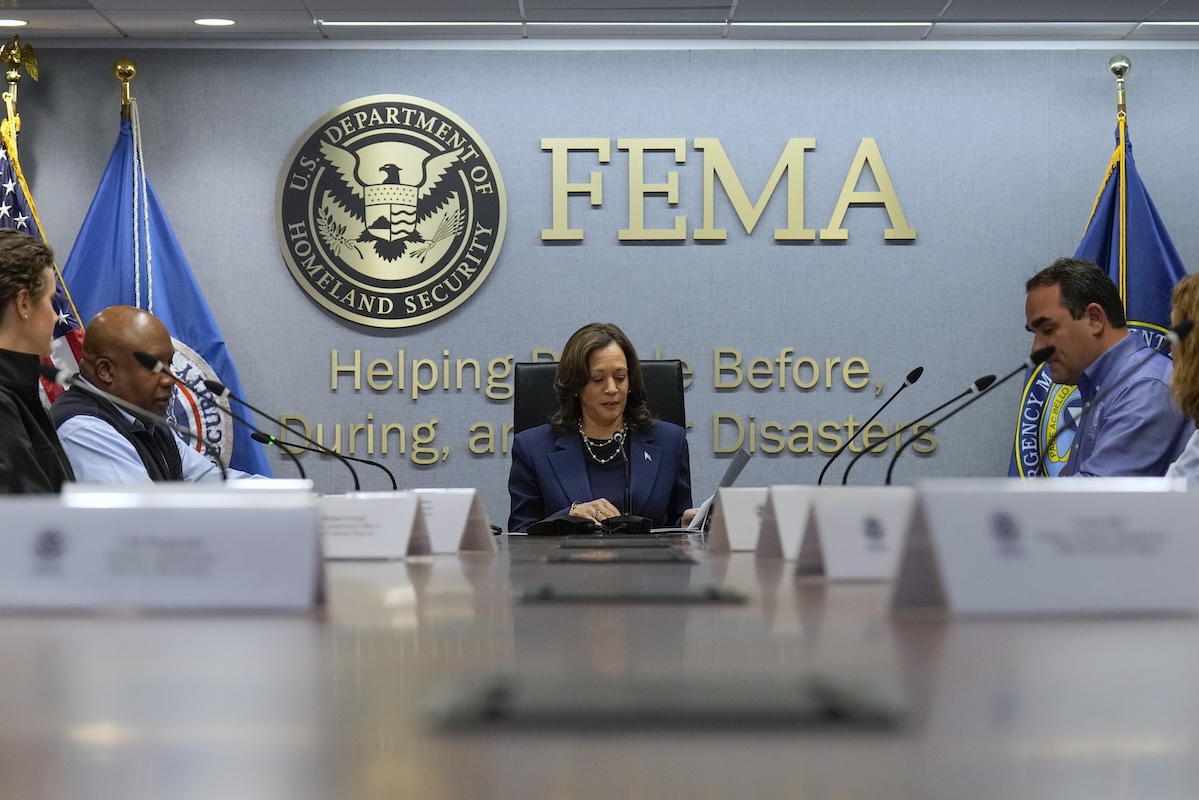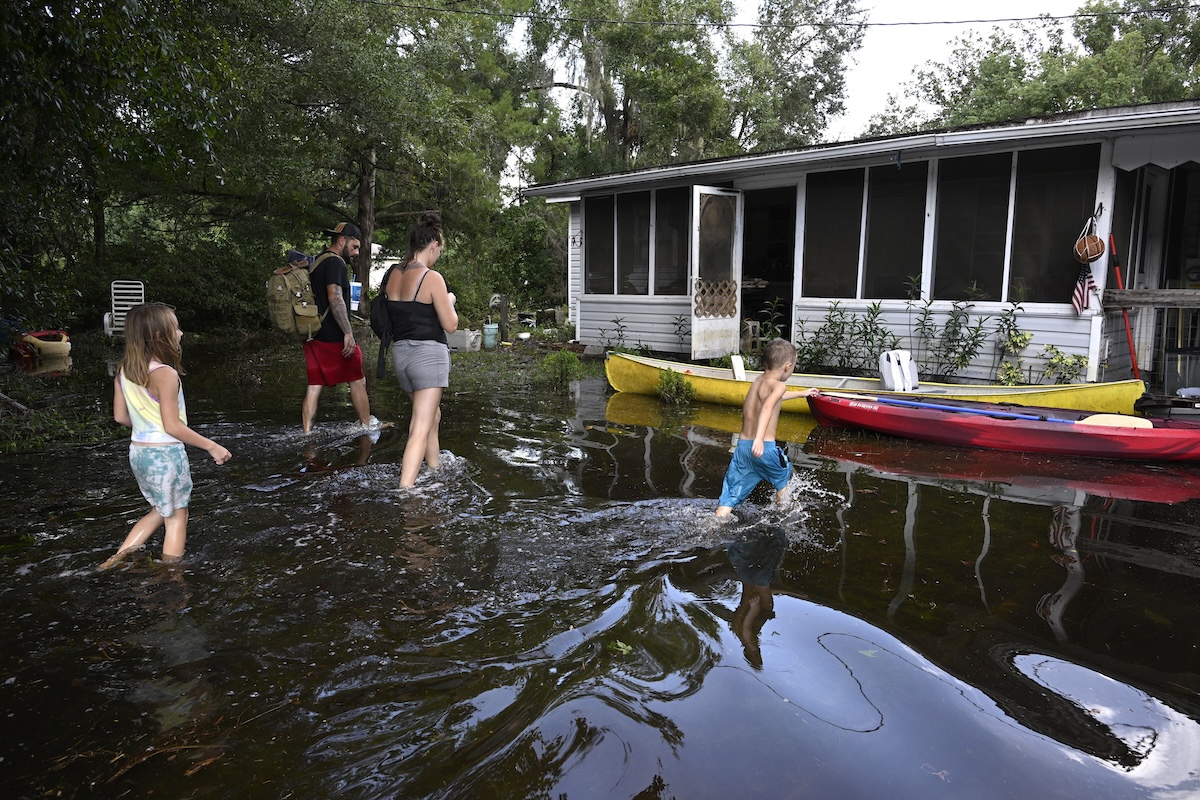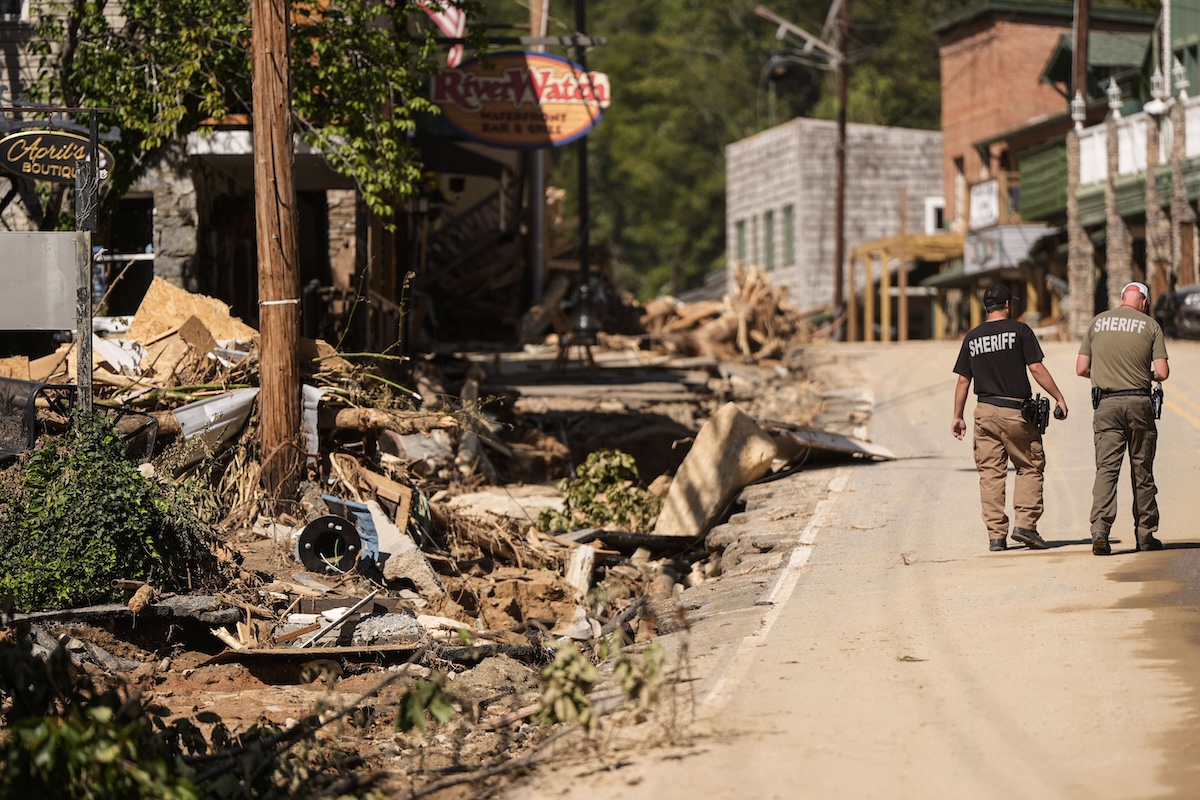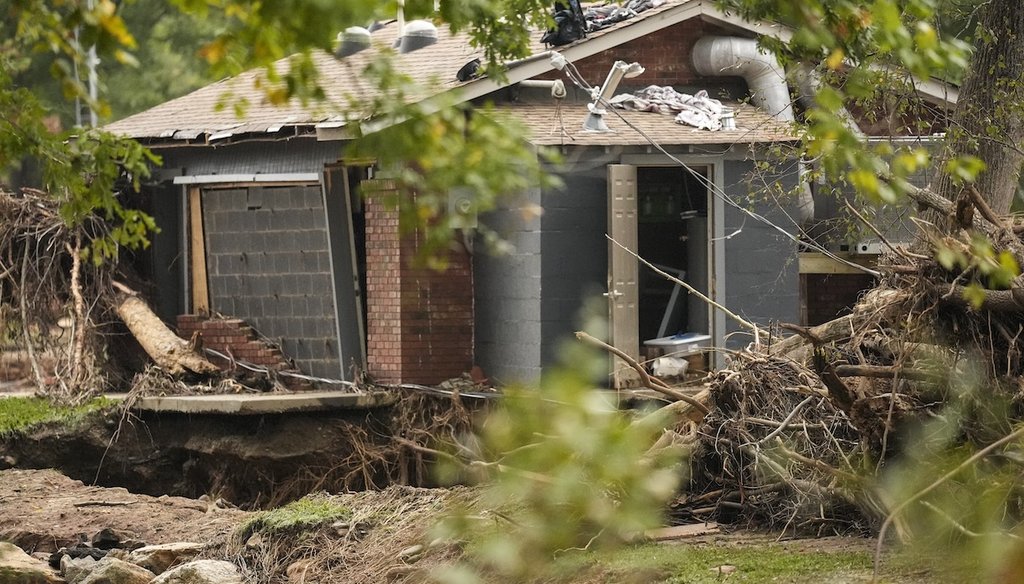

Our only agenda is to publish the truth so you can be an informed participant in democracy.
We need your help.


A building was damaged as water rushed over the roof in the aftermath of Hurricane Helene, Oct. 1, 2024, in Swannanoa, N.C. (AP)
Project 2025 outlines changes to the Federal Emergency Management Agency, including reducing the federal government’s share of local disaster relief contributions from 75% to 25%, privatizing flood insurance, terminating FEMA’s grants and raising the per capita threshold for providing FEMA public assistance.
Experts told PolitiFact the changes, if adopted, would reduce FEMA’s support to state and local governments and hinder disaster response.
Project 2025 is the conservative Heritage Foundation’s 922-page guide for an incoming Republican administration.
Hurricane Helene brought deadly storm surge, heavy winds and torrential rain that caused infrastructure-destroying flooding. As of Oct. 3, the storm and its aftermath had killed more than 190 people across six states and caused at least $20 billion in damage.
With the crisis still unfolding, some social media users focused on the federal government’s response — and how that response might change if Republicans win November’s presidential election.
"FEMA is going to be gutted. It’s written into Project 2025," a Sept. 28 Threads video said. Project 2025 will "cut FEMA" and "kill federal-backed flood insurance," said similar posts from critics of former President Donald Trump. FEMA refers to the Federal Emergency Management Agency.
Project 2025 is the conservative Heritage Foundation’s 922-page guide for an incoming Republican administration. Democrats have linked Project 2025 to Trump when attacking its proposals, but the document is neither an official Trump campaign position nor a Republican Party platform.
Trump has recently sought to distance himself from Project 2025, but several, high-ranking former Trump administration officials wrote it. Trump said in an April 2022 keynote speech that the Heritage Foundation would "lay the groundwork and detail plans for exactly what our movement will do."
Experts on emergency management and the federal budget said that several of Project 2025’s suggestions constituted significant cuts to FEMA.
Joshua Sewell, research and policy director at the federal budget-tracking group Taxpayers for Common Sense, said Project 2025 lacked necessary detail to evaluate the exact impact of its proposals.
"Changes called for in this piece could ultimately lead to less predictable, more expensive federal disaster response," he said.
A Project 2025 spokesperson said the plan’s proposals advocate shifting the agency’s focus away from climate change initiatives.
The full Project 2025 document mentions FEMA — in shorthand or by its full name — about 30 times, most often in a section written by Ken Cuccinelli, who served as Trump’s acting deputy secretary of Homeland Security.
Cuccinelli outlined four primary changes:
Changing the cost-share arrangement with local governments so that the federal government often covers 25% instead of at least 75%.
Privatizing the National Flood Insurance Program, which provides federally backed flood insurance to property owners and renters in participating communities.
Terminating FEMA’s grants.
Raising the per capita threshold for providing FEMA public assistance to disaster-stricken communities.
The plan also says that FEMA should be moved to the Interior Department or potentially combined with the Cybersecurity and Infrastructure Security Agency and both be moved to the Transportation Department.
Kathryn Van Tol, a legal fellow of emergency management at the University of North Carolina, Chapel Hill who once worked in North Carolina’s Division of Emergency Management, said that removing FEMA’s direct access to the Department of Homeland Security’s resources "could slow response and recovery."

Democratic presidential nominee Vice President Kamala Harris attends a briefing at FEMA headquarters, Sept. 30, 2024, in Washington, on recovery and assistance efforts after Hurricane Helene. (AP)
After a president declares a disaster, affected areas qualify for several disaster relief programs, most of which require states, tribes or territories to cover a share of eligible costs.
In most cases, FEMA covers at least 75% of the costs — sometimes increasing that funding for larger disasters — and the state or the jurisdiction receiving the funding covers the remaining 25%.
Project 2025 advocates for Congress to "change the cost-share arrangement," so the federal government covers 25% of the costs for small disasters "with the cost share reaching a maximum of 75 percent for truly catastrophic disasters."
It said it planned to adjust FEMA’s spending "to shift the majority of preparedness and response costs to states and localities instead of the federal government."
But it doesn’t define what qualifies as "small" or "truly catastrophic."
Sewell of Taxpayers for Common Sense said the change could constitute a significant cut, "but we can’t tell" without those definitions.
The change would "effectively invert the cost share for disaster relief" and leave local communities to bear three-quarters of the costs, Van Tol said.

Two adults and two children arrive to their flooded home in the aftermath of Hurricane Helene, Sept. 27, 2024, in Crystal River, Fla. (AP)
The National Flood Insurance Program often serves as an insurer of last resort in high-risk areas that private insurers avoid.
Project 2025 calls for the program to be "wound down and replaced with private insurance." A Project 2025 spokesperson proposed phasing out government coverage in low-risk zones where private insurers could enter the market. The phase-out would then expand to higher-risk areas that would see risk-based pricing and possible tax credits — or a hybrid public-private model providing a federal backstop.
Experts said such a scenario is unlikely given that private insurers have been historically unwilling to shoulder the risk of insuring properties in designated floodplains.
"The private sector has made very clear they’re not going to assume that risk," said Craig Fugate, who headed FEMA in the Obama administration after leading Florida’s emergency management under then-Gov. Jeb Bush. "They made that decision back in the ’60s, and it hasn't changed."
Sewell said eliminating the program "inevitably would mean many homeowners would either not have an insurance option, because a private insurance company does not step in, or would effectively not have one because a true risk-based rate would be unaffordable."
Grants are the "principle funding mechanism" FEMA uses to provide money for pre- and post-emergency or disaster-related projects, according to its website.
Its preparedness grants provide matching funds to supplement states’ and local governments’ efforts to prepare for emergencies, Fugate said.
But Project 2025 said FEMA grants should be terminated and states "should bear the costs of their particularized programs" instead.
States that experience disasters more often have more invested in preparedness efforts independent of federal support. But in parts of the country that budget for and have fewer disasters, terminating federal grants could amount to "cutting their programs in half," Fugate said.
FEMA also manages the Homeland Security Grant Program, which includes grants created after the Sept. 11, 2001, terrorist attacks to "enhance national preparedness" by building urban search and rescue teams and creating mobile command posts, Fugate said.
Using these grants, local entities have built up their response capacity, which means FEMA does less disaster response, Fugate said.
In many cases, the annual grant funding "is maintaining this capability that we built, not necessarily adding more to it," he said. "If you cut that program, I’m afraid we’d lose a lot of that capacity."
Cutting FEMA’s local preparedness grants could mean eliminating "half the salary of your local emergency manager." Cutting the Homeland Security grants could reduce funding for "formal communication systems that were sent into areas that lost all their public safety communications" during Hurricane Helene, he said.
Fugate and Sewell said terminating the grants would also be politically unpopular, regardless of political affiliation.
Van Tol said it would eliminate FEMA staff, reduce grant managers at local levels, and hinder local governments’ abilities "to effectively respond in a disaster to protect life and property of the citizens."

Two Sheriff deputies walk on the main street in the aftermath of Hurricane Helene, Oct. 2, 2024, in Chimney Rock Village, N.C. (AP)
FEMA’s Public Assistance Program provides grants to state, tribal and local governments and eligible nonprofits to help them recover from major disasters. FEMA partly determines whether a community qualifies for such a grant using a "per capita" or per-person estimated cost of assistance evaluation. In 2024, the per capita threshold across a state is $1.84 and for a county is $4.60.
"FEMA should raise the threshold," Project 2025 said, arguing that the threshold "has not kept pace with inflation." Alternatively, the document advocated for "applying a deductible" to encourage "states to take a more proactive role in their own preparedness and response capabilities."
Van Tol said raising the per capita threshold "would result in less disasters being declared in the first place."
The per capita threshold is increased periodically, but not every year, experts said. In 2020, FEMA proposed increasing the cost threshold for assistance, but a final rule has not been issued.
Van Tol said the threshold isn’t arbitrary: It’s "tied to the consumer price index" and "is intended to be a current reflection of market conditions."
Fugate said FEMA’s efforts to raise the per capita threshold are "met with a firestorm of opposition from both sides of the aisle in Congress."
Social media posts said Project 2025 would "cut FEMA" and "kill federal-backed flood insurance."
Project 2025’s proposed FEMA changes include raising the per capita threshold for providing FEMA public assistance, terminating its grants, replacing the National Flood Insurance Program with privatized insurance and changing FEMA’s cost-share so that federal government covers less of the cost for smaller disaster response and recovery.
Experts told PolitiFact that if these proposals became reality — surviving congressional opposition and overcoming what is likely to be limited private insurers’ support — they would reduce FEMA’s support to state and local governments, hinder disaster response and leave property owners with greater exposure and fewer options.
We rate this claim True.
PolitiFact Researcher Caryn Baird and Senior Correspondent Amy Sherman contributed to this report.
RELATED: What does Project 2025 say about the National Weather Service, NOAA and National Hurricane Center?
RELATED: How accurate are warnings by Democrats, Kamala Harris about Donald Trump’s ‘Project 2025 agenda?’
Threads post, Sept. 28, 2024
Threads post, Sept. 24, 2024
The Lincoln Project’s X post, Sept. 27, 2024
Project 2025, Mandate for Leadership, 2023
Phone interview with Craig Fugate, consultant and former FEMA director, Sept. 30, 2024
Email interview with Joshua Sewell, the director of research and policy at Taxpayers for Common Sense, Sept. 30, 2024
Email interview with Natalie Simpson, a professor of operations management and strategy, University at Buffalo’s School of Management, Sept. 30, 2024
Email interview with Kathryn Van Tol, a legal fellow of emergency management at the University of North Carolina at Chapel Hill, Oct. 1, 2024
Email interview with a Project 2025 spokesperson, Oct. 1, 2024
Reuters, Helene kills at least 90, homes and memories washed away, Sept. 30, 2024
PolitiFact, What does Project 2025 say about the National Weather Service, NOAA and National Hurricane Center? Sept. 26, 2024
PolitiFact, How accurate are warnings by Democrats, Kamala Harris about Donald Trump’s ‘Project 2025 agenda?’ Sept. 30, 2024
NBC News, At least 88 dead from Helene; floods, massive power outages devastate Southeast, Sept. 30, 2024
The Associated Press, Supplies rushed to communities isolated by Helene as death toll passes 100, Sept. 30, 2024
Fox Business, Hurricane Helene devastation could cost up to $34B, Moody's says, Sept. 30, 2024
Center for Renewing America, Ken Cuccinelli, accessed Sept. 30, 2024
Federal Emergency Management Agency, Stafford Act, accessed Sept. 30, 2024
Federal Emergency Management Agency, How a Disaster Gets Declared, accessed Sept. 30, 2024
Congressional Research Service, Stafford Act Cost Shares: History, Trends, Analysis, July 26, 2023
Congressional Research Service, A Brief Overview of FEMA’s Public Assistance Program, Feb. 28, 2024
The Marietta Times, DeWine’s June request for disaster declaration for flooding denied, sends another request, July 23, 2024
The Washington Post, Home insurers cut natural disasters from policies as climate risks grow, Sept. 30, 2023
The Tennessee Holler, About, accessed Sept. 30, 2024
Federal Emergency Management Agency, Flood Insurance, accessed Oct. 2, 2024
Federal Emergency Management Agency, FEMA Grants, accessed Oct. 2, 2024
Federal Emergency Management Agency, Assistance for Governments and Private Non-Profits After a Disaster, accessed Oct. 2, 2024
Axios, Hurricane Helene damages could hit $35 billion, Oct. 1, 2024
In a world of wild talk and fake news, help us stand up for the facts.
